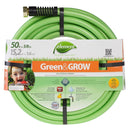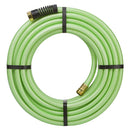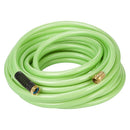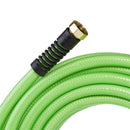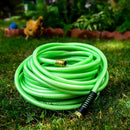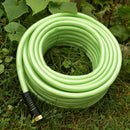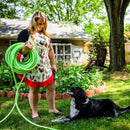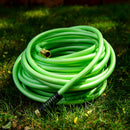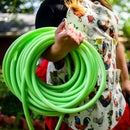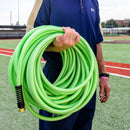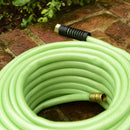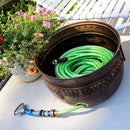Better hoses for a better world. That’s the promise of Swan’s Element® brand. And perhaps no other garden hose exemplifies this promise better than the Element® Green&GROW® garden hose.
Lead- and phthalate-free, the Element green and grow hose doesn’t add any toxic chemicals or harmful odors to your water supply, so you can be confident that it doesn’t pose any health risks to you and your loved ones. That makes this eco-friendly garden hose safe for drinking water and any task you wish, be it organic gardening, watering fruit trees or filling up a kid’s pool or birdbath.
With this drinking-water-safe garden hose, you also get a strong 300 PSI burst strength coupled with a 5/8-inch inside diameter for exemplary water flow, plus a lightweight, flexible design to help you drag and carry the water hose around with ease.
We’ve also added our patented Hose Armour® at the female coupling to prevent kinking at the water source where a garden hose is especially prone to tugging and kinking.
The light-green jacket, meanwhile, signifies the safety and environmental friendliness associated with Swan’s Element brand.
Lead- and phthalate-free, the Element green and grow hose doesn’t add any toxic chemicals or harmful odors to your water supply, so you can be confident that it doesn’t pose any health risks to you and your loved ones. That makes this eco-friendly garden hose safe for drinking water and any task you wish, be it organic gardening, watering fruit trees or filling up a kid’s pool or birdbath.
With this drinking-water-safe garden hose, you also get a strong 300 PSI burst strength coupled with a 5/8-inch inside diameter for exemplary water flow, plus a lightweight, flexible design to help you drag and carry the water hose around with ease.
We’ve also added our patented Hose Armour® at the female coupling to prevent kinking at the water source where a garden hose is especially prone to tugging and kinking.
The light-green jacket, meanwhile, signifies the safety and environmental friendliness associated with Swan’s Element brand.
- 300 PSI burst strength
- Medium-duty garden hose that’s free from harmful chemicals and odors
- Ideal for tasks such as organic gardening, watering fruit trees and filling the kid’s pool/birdbath
- Durable, flexible and lightweight
- Environmentally friendly garden hose
- Patented Hose Armour® prevents kinking at the water source
- Drinking water–safe: Meets the lead-free standards under the Federal Safe Drinking Water Act
- Meets the California Toy Standards for phthalate content
- Fits all standard faucets and most water accessories
- 10-year warranty
- 5/8” inside diameter
- Available as both a 50-ft. garden hose and a 100-ft. garden hose
- Made in the USA with global components
ID: Available in 5/8-inch
PSI: 300
Duty Rating: Medium
Weight:
- 50-feet - 4.6 lbs
- 100-feet - 10.6 Ibs
How Do I Set Up My Hose?
- Set up your hose outside in temperatures above 70 degrees Fahrenheit to ensure maximum flexibility.
- Remove all packaging and ties.
- Check that the washer is properly seated in the coupling that attaches to the water source.
- Unwind the hose loosely in a circular motion before attaching it to the water source.
- Run water through the hose until the water exiting the hose is cool.
- Leave the hose laid out straight and allow it to heat up during the day.
- Wind the hose back accordingly.
How Do I Care for My Hose?
- Disconnect your hose from any standard metal faucet/spigot/hose bib and metal hose attachment and then reconnect at least twice per year to maintain a proper seal of the washer.
- Before reconnecting, loosen any corrosion evident on the hose coupling, standard metal faucet/spigot/hose bib and metal hose attachment caused by weather or environmental elements, which can cause the hose to fuse to the faucet and/or attachment.
- Always inspect the washer for proper placement and clear any buildup on the washer, coupling or faucet. This will help prevent potential leaks.
- Never overtighten coupling connections. Normally, tightening the coupling connections by hand is sufficient. Using a wrench to tighten the couplings might stop a leak in the short-term; however, it can damage the washer, compromising it for future connections.
- Do not pull and stretch the hose to reach a watering location beyond the length of the hose. When the hose starts to pull off the ground, you put excess force on its connections to the water source and any attachment such as a nozzle. This will not only damage your hose, it can also damage the plumbing that feeds the water source, as well as the attachment.
- Be careful not to drive over your hose. This can damage the hose and drastically reduce its life.
- If your hose is left in a shady spot, its exterior can be cleaned periodically with a mild soap-and-water solution to reduce the chance of organic growth. How Do I Store My Hose?
- Drain your hose when you’re not using it. Water left in a hose for extended periods of time can cause bacteria to form.
- Once the hose is drained, the male and female ends can be connected for storage. Washer replacement is suggested annually or after a prolonged connection.
- When coiling the hose for storage, try to do so without leaving any kinks in the hose. A hose stored with kinks will most likely kink in these same locations very easily once the hose is put back in use. Prolonged kinks create weak spots in the hose.
- Store the hose indoors when not in use.
- Flush your hose with water when put back in use.
Warnings
- Do not run hot water through your hose (unless your hose is rated for hot water).
- Do not run liquids other than water through your hose as they are only designed for use with water.
- Do not leave the hose under pressure when not in use. Heat or pressure can damage your hose and cause it to leak or burst.
- Our hoses are not intended for indoor use. Garden hoses are intended for use in residential and/or commercial water systems that have typical average water pressures up to approximately 100 PSI. Garden hoses should not be used for system pressures based upon burst rating.













